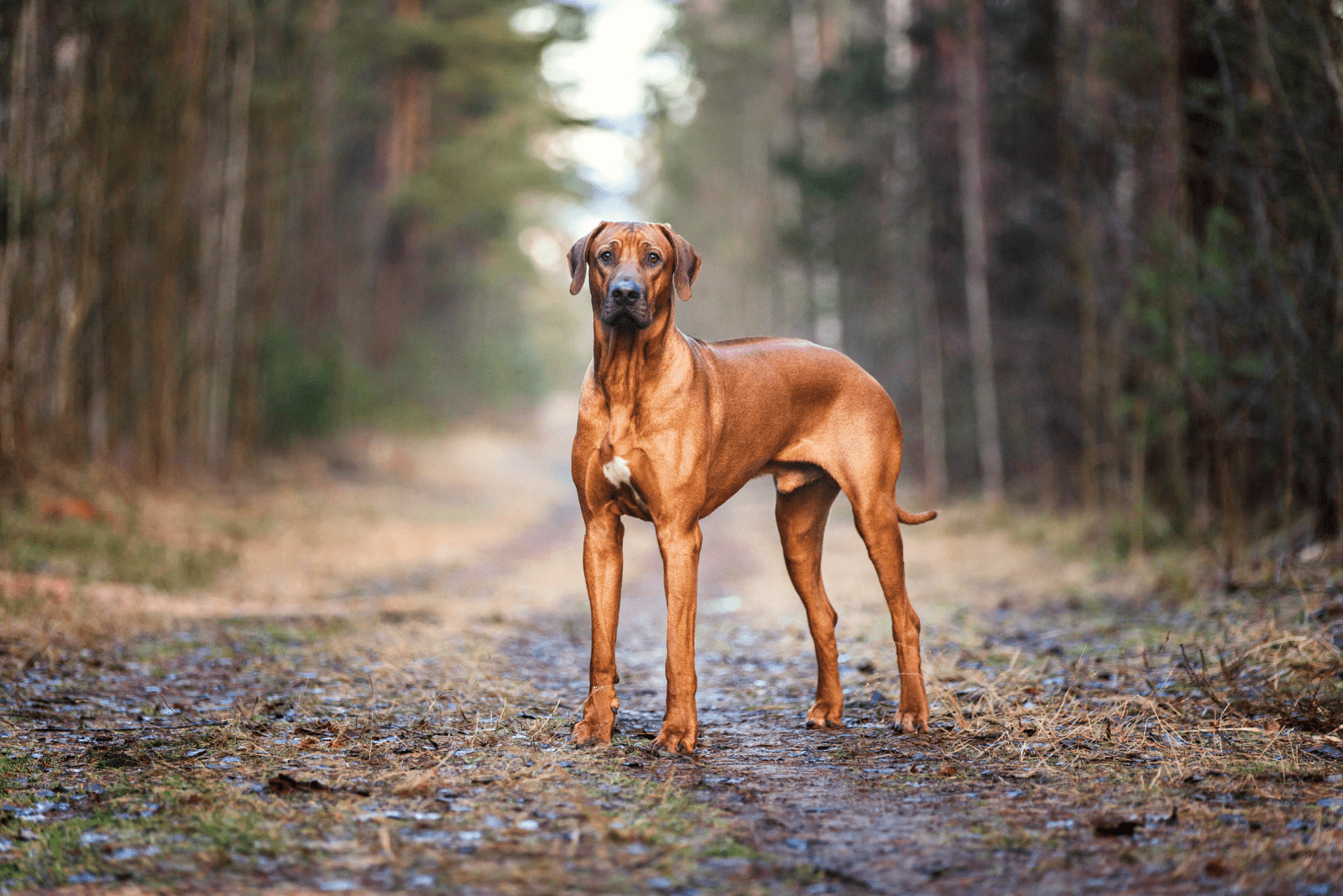A dog breed that not everyone really knows about, the great Rhodesian Ridgeback, and by great, I mean in both quality and size. They get really massive which is why I’m here to present you with the Rhodesian Ridgeback growth chart.
The Rhodesian Ridgeback growth chart serves as a guide on what you should expect from your doggo as he goes throughout his life cycles and so you can better prepare for the growth spurts ahead, and the challenges that they bring.
At first glance, they may not seem all that much, but they grow up to be almost 30 inches long and end up weighing over 80 pounds.
They are considered a large breed, but the lack of mass amounts of fur may trick you into thinking he’s smaller than his equally large friends.
Originally from Africa, the Rhodesian Ridgeback was made to be a great guard dog and hunting companion.
The dog breed has incredible focus and endurance, usually sporting a pretty imposing presence as well, only further aiding them in their intended roles.
Rhodesian Ridgebacks make for great and loyal canine companions who are extremely territorial and care about their family, be it his pet parents or his own offspring.
That said, they can be really tough to train, and training needs to be done early to have a proper effect, as subduing such a dominant personality can be nigh impossible otherwise.
It’s certainly not a breed recommended for a novice dog owner, but you’re welcome to try, as long as you know the risks.
In case you decide to go for this magnificent dog, you’ll definitely need to be familiarized with his growth throughout his lifespan.
To find out more about that, as well as any unique things about a Rhodesian Ridgeback dog breed’s growth or any other commonly asked questions regarding it, be sure to keep on reading to find out.
The Rhodesian Ridgeback Growth Chart
[table id=651 /]
As you can see on this Rhodesian Ridgeback puppy weight chart, his progress starts up pretty quickly, gaining about 7 pounds of weight a month on average for the first 6 months.
The gain then gradually starts reducing its increments to around 5-6 pounds per month and scales further down to 2-4 until the very end.
That comes naturally, given how they’re fed and how big these dogs get, their full growth and weight often achieved in a year and a half, give or take, though they’re already shaping up for their adulthood by month 9 until finally reaching it at around month 14.
Their developmental stages vary from month to month. Sometimes the difference isn’t big enough to be noticeable, sometimes it’s massive.
Do keep your dog’s weight in mind. If it’s lower than indicated on this chart, I’d advise taking him to a vet for a check-up as there may be something wrong with him, be it some parasitic worms or some other weight related condition.
When Do Rhodesian Ridgebacks Reach Proper Adulthood?
While it varies somewhat, Rhodesian Ridgebacks are often considered adults when they reach anywhere from 12-16 months of age, give or take a few months.
The value varies depending on how each dog has been raised, what he has been fed and if he has received adequate training and nutrition.
Naturally, genetics will also play a big role in that variance just like it does in humans.
The difference can be in the dog’s gender too as males are bigger than females so it may take them longer to reach their full adult proportions.
Some dogs may even take a full 24 months to reach their cap in weight and dimensions.
Rhodesian Ridgeback Growth Chart – Step By Step
With the abbreviated version placed up above, it’s time to get into a little bit more detail about how this wonderful dog breed is usually raised in its puppy period.
Up To 2 Weeks Of Age
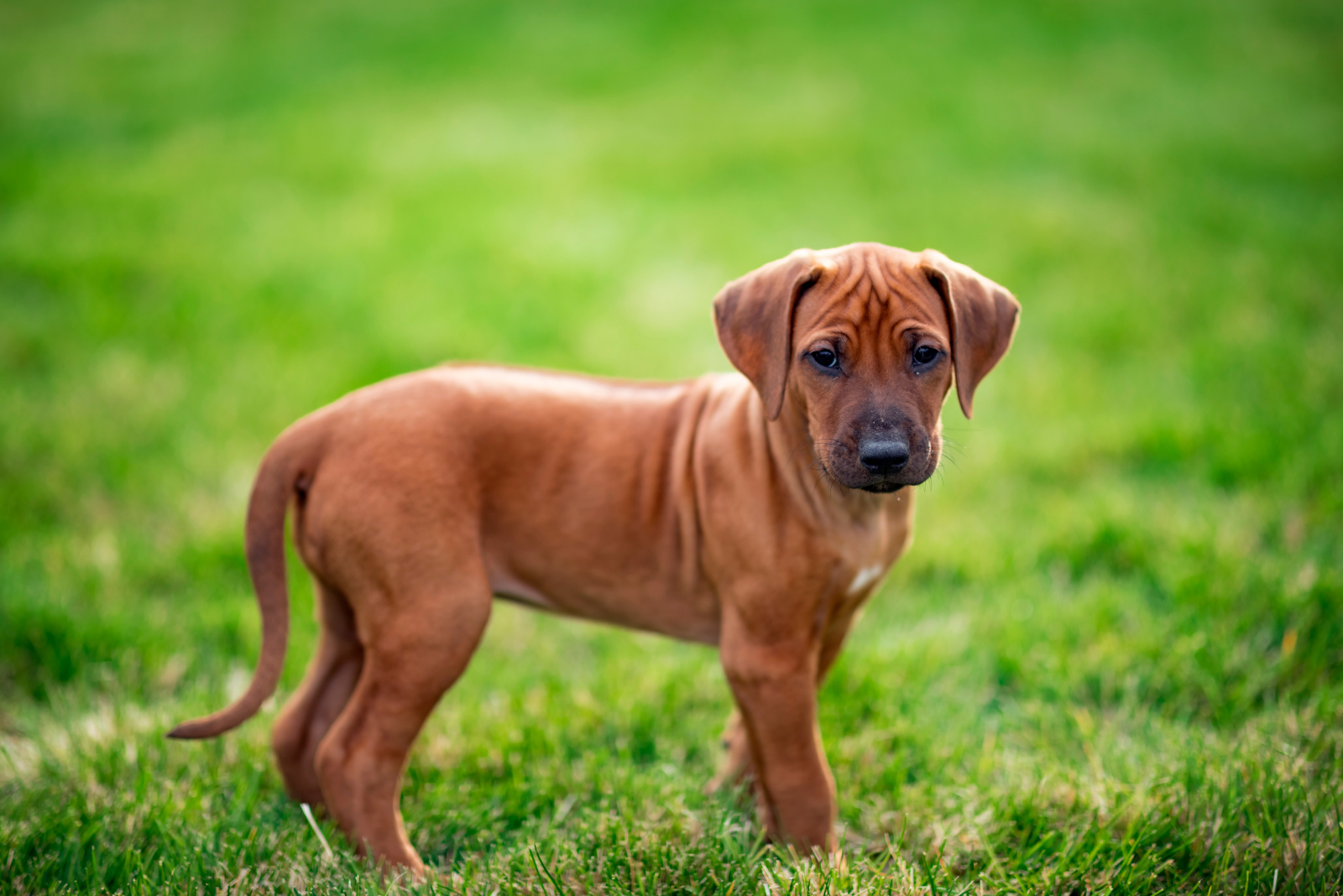
In these initial stages, you’re not going to be doing much with the pups themselves if you’re raising them, their mother is.
She’ll be the one providing them with the comfort and nutrients that they need.
They’re rather frail and weak and will require her guidance, she’ll be their beacon that they’ll flock toward as she’ll represent safety and food.
Most of them won’t even have the ability to see quite yet, but can manage a lot of the other functions, however their mom is there to coral them in the meantime.
At this stage, your duty is to provide the mom with plenty of food and water as she has to provide not only for herself, but for her litter of pups too.
3 To 4 Weeks Of Age
At this point, your pups will finally open their eyes and have enough of a muscle structure developed to be able to waddle around the place a little, but they’ll still be dependant on their mother’s milk for sustenance,
They’ll slowly be gaining weight too, enough to fill themselves out nicely for a pup of their size.
4 To 8 Weeks Of Age
In this period, the Rhodesian Ridgeback puppies will slowly start weaning themselves off the mother’s breast and should swap to food that you provide them with.
Usually the transition is gradual by softening the kibble up with water to make it easier to manage and to slowly ease the dog into the new stuff.
This is also done for the sake of their teeth which haven’t exactly grown in fully and aren’t able to manage dry kibble as well as a grown adult would.
It’s key that they adapt to something that isn’t mother’s milk as a new food source as by the end of week 8, they’re likely getting bought or adopted into a new home and the prior food source won’t be available.
Not to mention the pup will lose his littermates which can be a tough blow, but it’s all a part of growing up for a doggo.
Thankfully, the mom helps with the food issue at least by making her kids fend for themselves as they get older.
8 To 12 Weeks Of Age
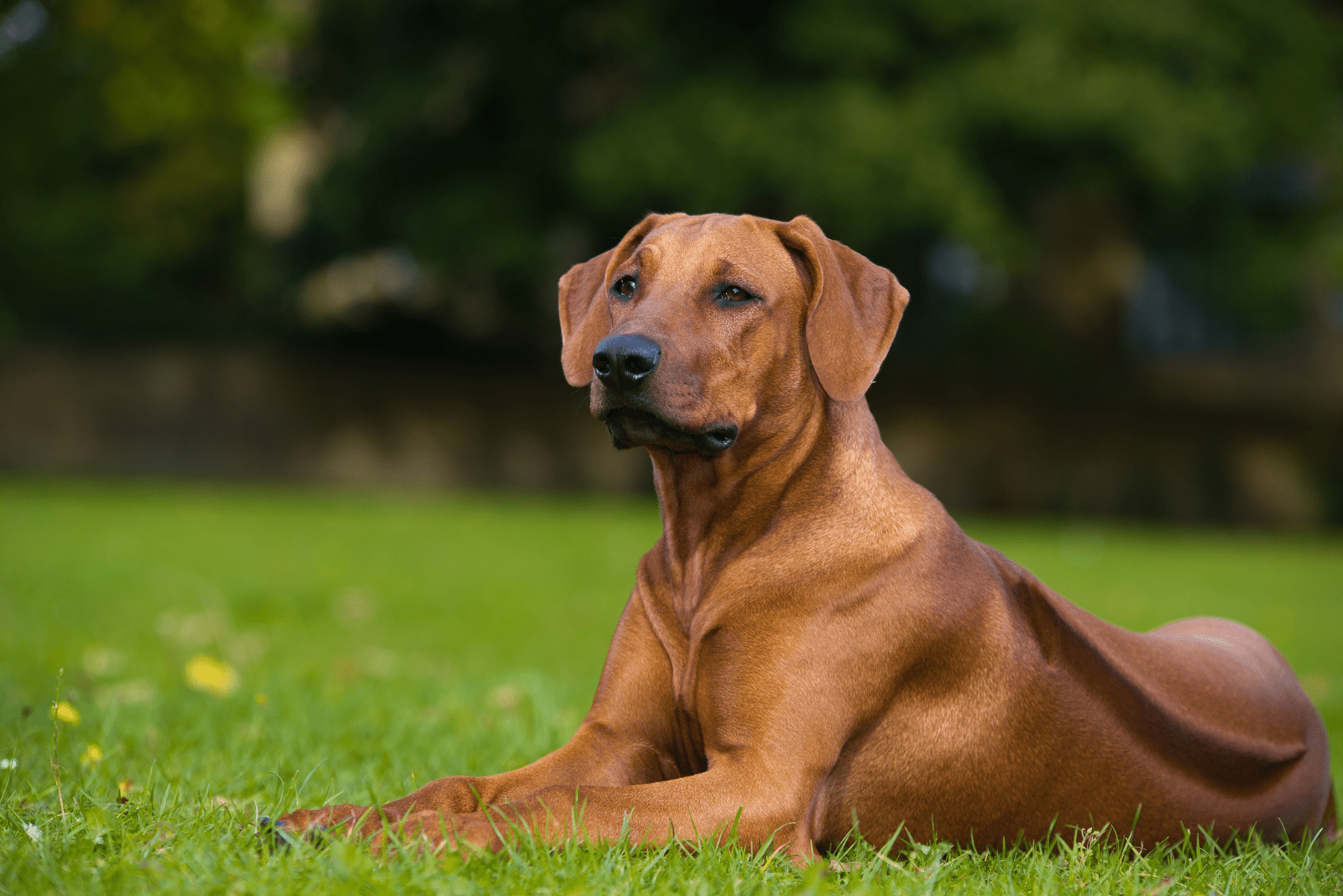
If you’ve bought a Rhodesian Ridgeback puppy, it’s likely that you got him when he was around 2 months old.
He should be sporting a healthy weight and the breeder should’ve given you the details on what he has been eating and how much and to follow through with it for the time being.
You can always swap his food options out later if you choose to do so, but make sure it’s gradual and done in a similar manner to the earlier adaptation process of gradually adding more and more of the new dry dog food while filtering out the old.
Their teeth should be coming in nicely now and they should be growing up quite rapidly when they start closing in around week 12 and being more physically active to adapt to their rapidly changing form.
It’s also around this stage that you should start considering dog training. The earlier the better, especially for this prideful dog breed.
I’d argue that when you have a 12 week old pup, it’d be a good time to start.
2 To 9 Months Of Age
Your dog is starting to show signs of rapid growth as he transitions to his adult weight and overall form, his muscles are likely developing at the same time and he’s starting to look more like his final form, so to speak.
During this period, you should expect him to gain somewhere around 50 pounds which has to go somewhere.
His teeth will finish up forming too and he’ll be able to tackle tough foods without the assistance of water.
He needs to practice his biting though, so getting him a chew toy or two would be great to help him master his new set of chompers.
They’ll also help alleviate any teething pains while the teeth are still on their way in.
He’ll start getting more of an attitude too, so I hope you can restrain him and keep him in check, and hopefully you’ve begun with his obedience training whose signs should be starting to show by the end of this period.
9 To 18(ish) Months Of Age
The final stretch before adulthood spans a good 5 to 9 months, depending on the factors mentioned prior, mainly their upbringing, diet and exercise.
Everything mentioned before happens in this period too, though the weight gain slows as your dog starts finding a balance between food and exercise, and you keep him on a proper diet, of course.
It’s also the dog’s puberty period, in a sense, a time where they’ll start experiencing sexual activity.
They’re different for male and female dogs alike with the former getting theirs relatively often throughout the year while the latter only goes into heat once or twice per year, albeit theirs lasts longer.
This should also be about the time when your dog comes up to his final, adult weight, where he’ll stop growing and will slowly transition into adulthood, finalizing our Rhodesian Ridgeback puppy growth chart.
Adulthood (14 Months To 7 Years Of Age)
By this point, your doggo has finally become a full grown adult. There are still likely to be some gains in weight, but it’s good if you keep him within a certain healthy range.
That’s something your dog’s vet or a pet nutritionist are going to be able to precisely determine based on your dog’s build.
As he grows older, he may even start losing some weight as his metabolism slows down and he becomes less active, reaching his senior years.
But, that shouldn’t happen until the tail end of this period, so he should be more than fine to still be as active as his breed is always described as.
Just make sure to keep up with his diet and you should be alright for the most part, barring any underlying health issues that may rear their ugly heads.
If he’s a few pounds over, it’s normally fine, but make sure it’s not too much. Being a few pounds under is a bigger concern in all honesty, but I’d still advise trying to keep him in the healthy weight range.
7 Years And Onward
The average lifespan for a Rhodesian Ridgeback is about 10-12 years, so they don’t get that much of it, mainly due to being one of the larger dog breeds which often have issues with hip dysplasia and bloat among others.
Regardless, the amount you should be feeding your dog in this period should gradually decrease to match his slowing metabolism.
What Affects A Rhodesian Ridgeback’s Growth?
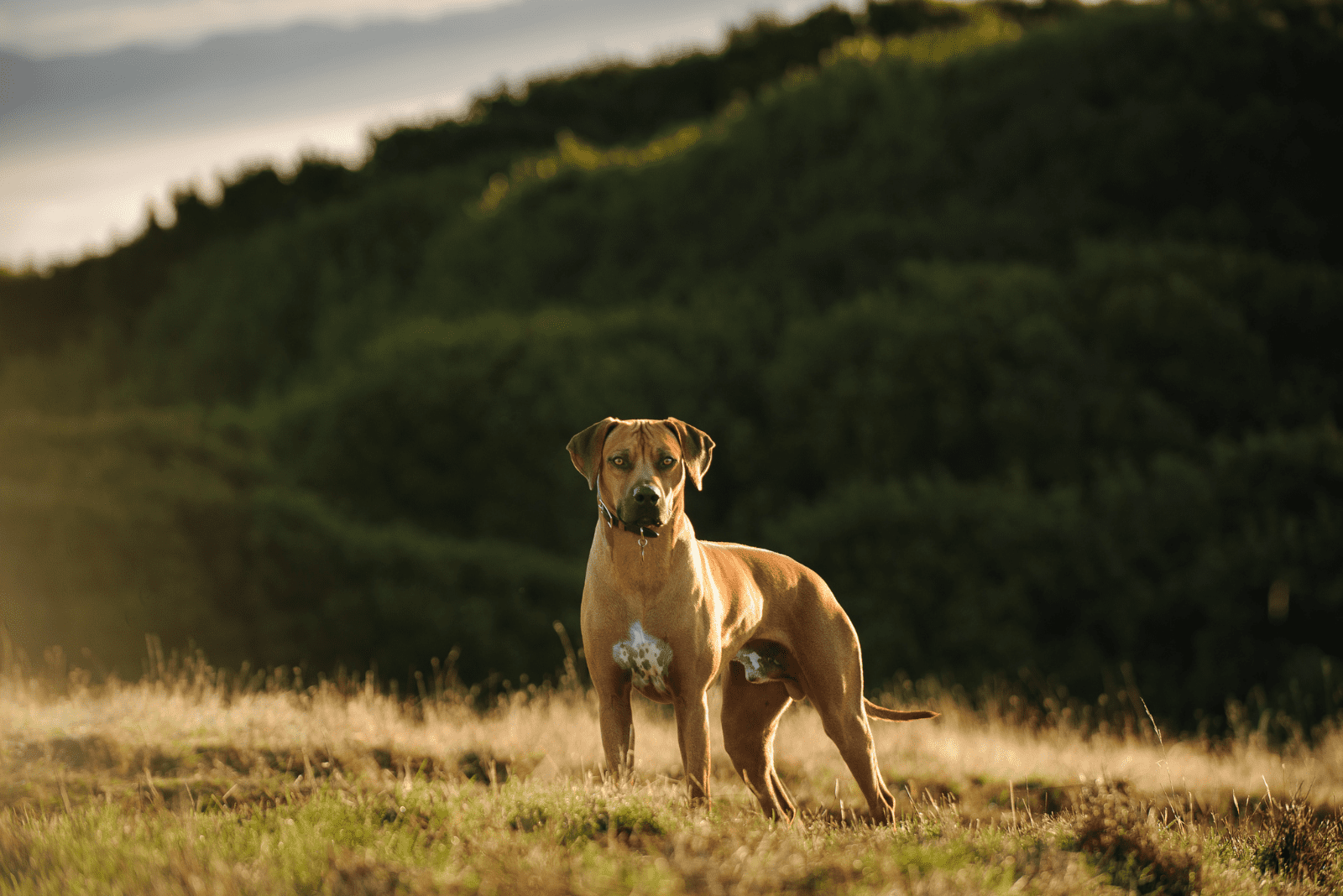
I’ve touched upon this topic a little bit earlier, but I felt like I needed to further elaborate on it.
In essence, there are a few main factors you’ll want to keep track of, ones that can get pretty taxing over time if you can’t keep up:
His Genes
As with every physical function, genes play a vital role in proper physical development, be it weight gain or growth rate.
They also play a key role in appearance too and many other factors like genetic health problems, hereditary disease and such, all things that you’ll need to factor in for when you get a Rhodesian Ridgeback.
Obviously, other dogs are prone to all of this too, but given the rapid growth of the Ridgeback in both height and weight over such a short period of time, a lot can go wrong depending on his genetics.
Keep a close eye on him and if anything seems or feels out of place, give your vet a call to get him checked up.
His Diet
You are what you eat, as the old saying goes, and that definitely stands true for dogs too.
While he’s still young, he needs proper nutrition, and a good amount of it.
That weight has to come from somewhere after all.
But not just any food, it can’t all just be empty calories. It needs to have the necessary vitamins and nutrients needed for a dog’s system to thrive.
Plenty of calcium and phosphorus for healthy bones and cartilage, DHA for the proper development of cognitive functions, and an assortment of minerals, carbs and vitamins to further strengthen the body.
Lets not forget the most important part, the protein. Dogs, much like humans, need protein to facilitate muscle growth and improve overall bodily functions, so a good quality protein is recommended in your dog’s diet.
This rings especially true for dogs like the Rhodesian Ridgeback given how much food he’ll need to wolf down.
While it won’t get extremely pricey, it’ll likely be more expensive than the diet of any other dog breed, e.g. a Beagle, a Golden Retriever or a Great Dane.
It’s worth keeping it in mind.
His Levels Of Exercise
Naturally, as with any dog or living being, the amount of physical exercise plays a big role in how their growth is affected.
Whether it’s burning calories through proper daily exercise or allowing the body to properly function by getting enough sleep, exercise will always affect these matters.
A Rhodesian Ridgeback in particular wants at least 2 hours of physical exercise daily.
This may sound like a lot, but that’s what this dog breed requires.
If you believe that you’re unable to fulfill this requirement, you may want to consider getting a different dog breed like a Bulldog, a Mastiff or a German Shepherd, or something similar that doesn’t require as much physical activity.
What ‘s The Final Size That A Rhodesian Ridgeback Gets To?
The numbers you’re going to be looking at depend on whether your dog is male or female.
For Rhodesian Ridgeback females, the average is a bit lower than the males, reaching around 70 pounds weight wise while their height comes up to 25-ish inches, give or take.
For the Rhodesian Ridgeback males, on the other hand, their average size comes in at 26-ish inches, but their weight comes up at around 85 pounds.
It’s quite an accomplishment, considering that they start at a mere 10 pounds, and all of this happens within a year’s time.
This is one of the other reasons why this dog can be a handful, having to constantly monitor his current weight and adjusting the diet on the go if something is off. It can be pretty demanding to keep up with.
Certainly more demanding than small breeds like Poodles, Chihuahuas or Dachshunds would be.
FAQs
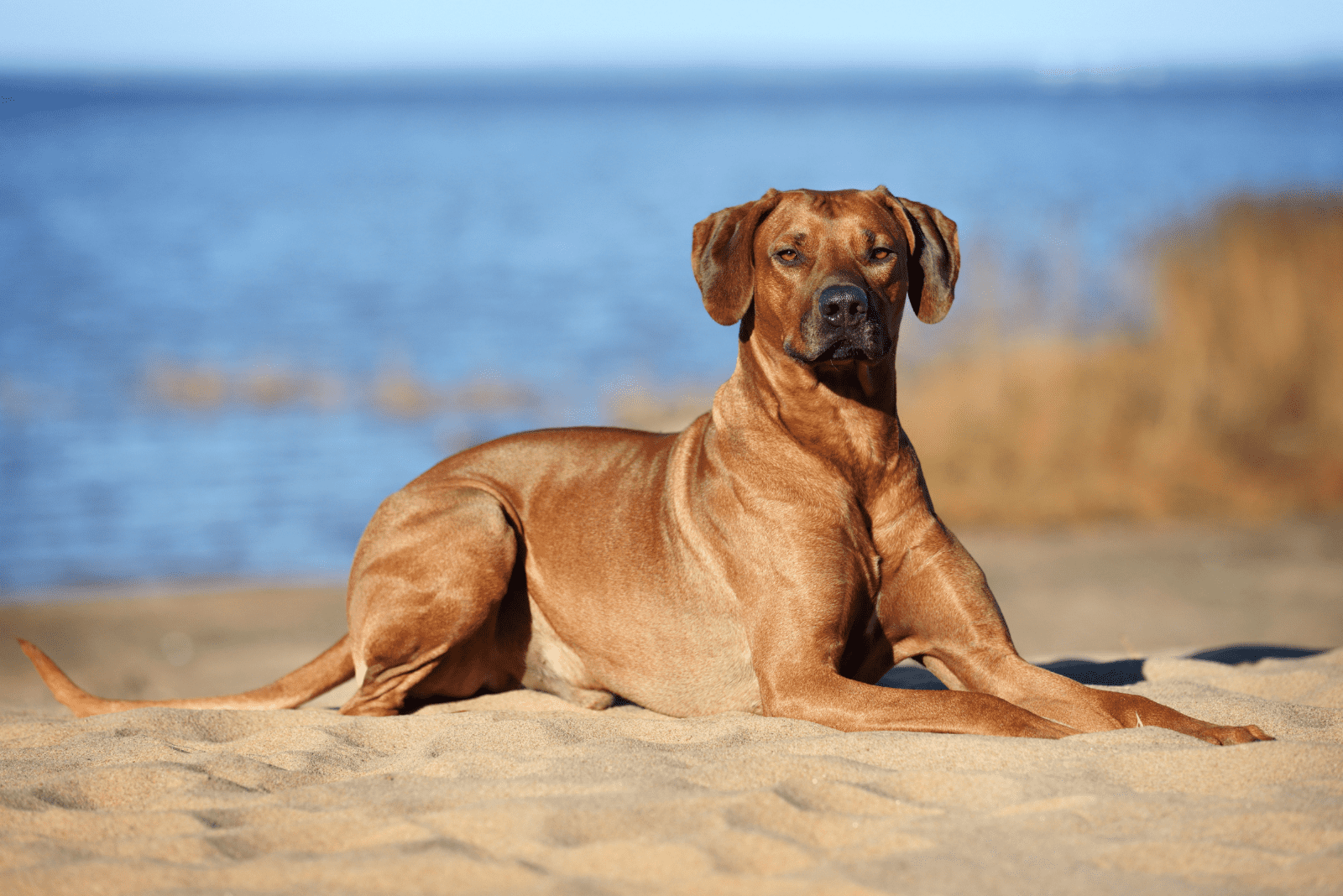
How Long Do Rhodesian Ridgebacks Live For On Average?
Seeing how a Rhodesian Ridgeback is a large dog breed, their life expectancy is lower than that of medium and small dog breeds averaging out at around 10 to 12 years.
This number is affected by the same factors as their overall growth is, especially the genetics part which can indicate a predisposition for specific canine diseases.
Though, through a proper diet and proper exercise, their life expectancy can be extended somewhat.
However, even 12 is a long time for large dog breeds considering the issues that often plague them, namely hip dysplasia and bloat due to their awkwardly placed center of mass which wears them down over time.
Which Health Problems Should I Be On The Lookout For In Rhodesian Ridgebacks?
Normally the Rhodesian Ridgeback is a relatively healthy dog, but age catches up with all of us, including your furry friend. Once he reaches his adult size, he’ll start becoming more prone to a number of potential health issues.
There are a few specific health conditions to be on the lookout for with Rhodesian Ridgeback that aren’t just size related.
The main problems that plague Rhodesian Ridgeback are often tied to their thyroid and their eyesight, being prone to cataracts and persistent pupillary membranes.
Some can also suffer from degenerative myelopathy, a disease that affects the spinal cord which can gradually paralyze your dog.
Hip and elbow dysplasia is also relatively common as mentioned before, especially considering their rapid weight gain and the mass they have to contend with throughout their life.
Though, hip and elbow dysplasia are pretty common issues in older dogs of large dog breeds as their bone structure gets worn away with time, regardless of levels of physical exercise or any other factors.
Some specific ones can even develop progressive deafness, albeit it’s rarer than the other potential problems.
Again, genes will determine whether or not your dog may be affected by these, but it’s always good to get informed about them just in case.
How Much Do Rhodesian Ridgebacks Cost On Average?
These South African hunting dogs certainly aren’t cheap to get, especially when getting purebreds.
The average price for one comes up to around $1300 with the lowest price coming in at around $600 and going all the way up to a whopping $2000 on the higher end.
They’re a pretty rare dog breed so it’s unlikely that you’ll find one in shelters either. You’ll most likely have to shell out the money.
And this is just the purchase, there are still maintenance costs to consider: vaccinations, grooming, training, food, toys and other tools like leashes, collars, cages, medication and the like.
The first year can get quite pricey, coming in at over $4000, but dropping down to around $1500-$2000 annually afterwards.
What Coat Colors Does The Rhodesian Ridgeback Come In?
There aren’t that many fur color options for the Rhodesian Ridgeback aside from wheaten, however, this color can come in a variety of different shades depending on the dog’s genetics.
So, you can still get some semblance of variety, but don’t expect wildly differing color palettes.
What Can I Do To Make Sure My Rhodesian Ridgeback Puppy Grows Up Healthy And Well Adjusted?
I’ve kept saying that Rhodesian Ridgebacks are a handful to manage, which is quite true, but here’s why exactly.
Some of their issues stem from their innate behavior, while some are more related to their health and dietary needs which can sometimes be hard to keep up with:
1. The Temperament
The biggest issue you’re going to have to deal with is this stubborn doggo’s temperament.
He has a natural prey drive which is extremely high given his background as a hunting dog that was often used in capturing lions.
This gave him this extremely prideful and headstrong nature, one that’s extremely hard to tackle aside from the side of the hardiest dog owners.
He likes to think of himself as the alpha and the protector, but you’ll need to show him that he’s only second to you.
You need to ingrain this into him from an extremely early age, usually done when he reaches 2 months of age.
The concept of tough love usually works best in this case, you’ll need to be stern, but fair in your training, one that’ll punish stepping heavily out of line and reward good behavior.
Providing him with proper socialization around other dogs and kids will help teach him how to properly behave around them, how to temper his approach and consider them as equals.
They’re not the most aggressive, but their default nature may end up having them overstep and scare other dogs or humans even if that wasn’t your dog’s initial intent.
If you can manage to curb his temperament however, you’ll have one of the greatest and most loyal family protectors on hand.
2. The Diet
While not the pickiest of eaters, a Rhodesian Ridgeback will require a ton of food in his first 14-18 months of life.
He’ll start off relatively small, but his rapid growth needs to be sustained by nutrients and energy which he gets through food.
Making sure said food has plenty of vitamins, minerals, particularly DHA for healthy development of cognitive functions, and calcium and phosphorus for strong bones and cartilage, will be crucial alongside meeting his daily calorie requirements.
It’s worse when you have to deal with allergies, but that’s just par for the course for any dog breed and not exclusive to the Rhodesian Ridgeback.
Once you find the right kibble, things should progress relatively smoothly, though your monetary budget will need to keep up.
After the first year, however, it eases back up.
3. The Health Issues
Being a large dog breed, Rhodesian Ridgebacks suffer from a number of health problems, ones that I’ve already mentioned prior.
The main problems will often be related to hip and elbow dysplasia and problems relating to his thyroid gland or his eyesight most of all.
These are hard to avoid and will eventually happen with age, cataracts in particular in regard to eyesight.
While frequent check-ups with the doctor can help, the builds of large dog breeds do make the issues with the joints a recurring issue, but can be mitigated through proper nutrition, at least to a degree.
A few others exist, but are rarer in nature.
The thing that makes this difficult mostly relates to your emotional state, and partly to your finances as visits to the vet aren’t cheap.
Though, if fed and exercised correctly, Rhodesian Ridgebacks are usually healthy for most of their adult lives and only start seeing these problems in their senior years.
How Bad Is It If My Pup Is Underweight?
Well, it can mean one of two things. One is a lot less harmful than the other in the fact that it may just be a sign of a late bloomer.
The other could mean that something is wrong either with the food or the dog’s digestion in general.
Whether it’s some sort of parasite that’s taking away from his nutrients or something else that’s wrong with his digestion, it’s never exactly clear as the symptoms are often similar.
You should get him over to a vet if he seems sluggish in his movements and if he’s generally looking like he’s low on energy, or if he’s suffering from bouts of vomiting or diarrhea.
You can also just bring a fecal sample over to the vet too so you don’t have to bother your doggo with the trip.
It should be enough to help him discern what’s wrong with his digestive tract and he should be able to provide you with the proper steps to helping you treat your precious pooch.
In Conclusion
The Rhodesian Ridgeback growth chart shows us how this beautiful dog breed grows throughout its lifecycle.
It’s a bit different than that of some other dog breeds with their unique growth rate, one that practically explodes in their puppyhood with how rapid it is, both weight and height wise.
They’re certainly a challenge to socialize and ‘tame’ given their strong prey drive, certainly tougher to manage than say a Boxer or a Doberman.
They also suffer from a number of health issues and can be quite pricey to maintain, especially during puppyhood.
Definitely not the most recommended choice for first time pet parents, but for those who can manage them, they’re some of the finest guard and watch dogs out there.
If you’re still adamant about getting one, I hope that this growth chart manages to help ease some of these hurdles and that your kennel will be graced by this extremely loyal canine. Until next time.
RELATED LINKS:
